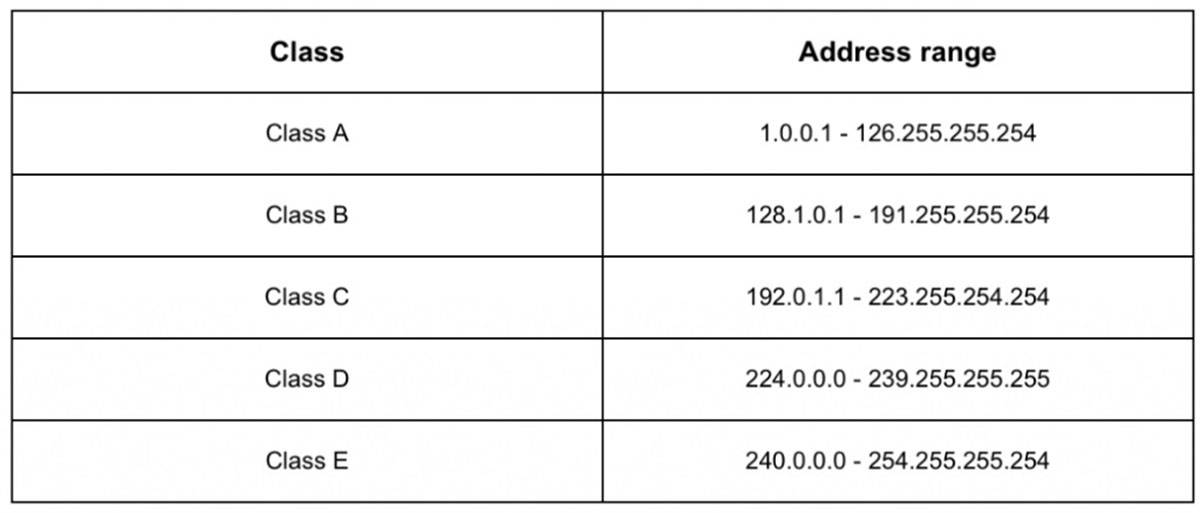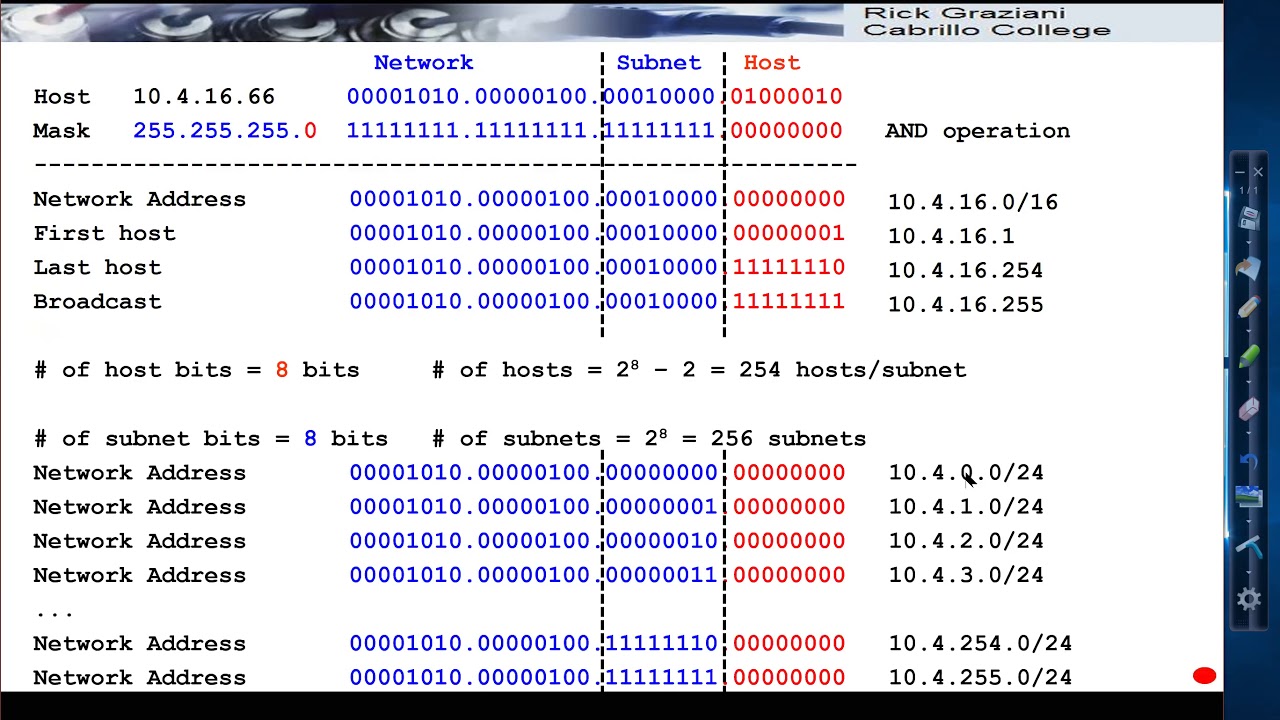Introduction
As the internet continues to evolve and expand, understanding the concept of an IP range becomes increasingly important. Whether you’re a website owner, network administrator, or simply a curious internet user, knowing what an IP range is and how it works can provide valuable insights into the world of networking and connectivity.
An IP range, short for Internet Protocol range, refers to a range of IP addresses that are grouped together based on a specific pattern. It allows for the identification and communication of devices within a certain network. Each device connected to the internet is assigned a unique IP address, which serves as its “digital signature.” These IP addresses can be classified and grouped in various ways to form IP ranges.
The benefits of using IP ranges are manifold. They enable efficient and organized management of network devices, making it easier to control access, monitor traffic, and apply security measures. By defining IP ranges, administrators can regulate which devices or users are allowed or denied access to specific resources or services.
Defining an IP range involves specifying the starting and ending IP addresses that fall within a particular range. For example, an IP range could encompass all IP addresses between 192.168.0.1 and 192.168.0.255. This allows for the grouping and management of devices within that range.
There are two main types of IP ranges: classful and classless. Classful IP ranges follow a predefined structure, meaning the network identification and host identification portions of the IP address are fixed. Classless IP ranges, on the other hand, are more flexible and allow for a wider range of IP addresses within a given network.
What is an IP Range?
An IP range, also known as an Internet Protocol range, is a set of consecutive IP addresses that are grouped together based on specific criteria. In simple terms, it is a range of numbers that represents a block of IP addresses. Each IP address consists of a series of four numbers separated by periods, such as 192.168.0.1. The range typically includes a starting IP address and an ending IP address.
IP ranges are used to define and manage networks, allowing devices within the range to communicate with each other and access network resources. They play a crucial role in routing data packets across the internet and ensure that information reaches its intended destination.
By using IP ranges, network administrators can efficiently organize and control access to their networks. For example, a company might assign a specific IP range to its employees for internal use. This allows for easy identification of company devices and allows network administrators to implement security measures and monitor network activity.
Additionally, IP ranges are also vital for managing and allocating IP addresses within an organization or internet service provider (ISP). ISPs typically have a pool of IP addresses that they divide into smaller ranges to assign to their customers. This ensures that multiple users can connect to the internet with unique IP addresses without overlap.
IP ranges can be further classified into two main types: classful and classless. Classful IP ranges were used in the early days of the internet and followed a strict hierarchical structure. However, with the increase in the number of devices connected to the internet, classless IP ranges have become more common. Classless Inter-Domain Routing (CIDR) notation allows for more flexibility in defining IP ranges and efficiently allocating IP addresses.
Benefits of using IP Ranges
Using IP ranges offers numerous benefits for network administrators and organizations. By organizing and managing devices within specific IP ranges, the following advantages can be realized:
- Efficient Network Management: IP ranges provide a systematic approach to managing devices within a network. By assigning devices to specific ranges, administrators can easily identify and categorize devices based on their purpose, location, or user group. This simplifies network administration tasks such as monitoring, troubleshooting, and security configuration.
- Enhanced Security: IP ranges enable administrators to implement granular security measures. By assigning different access permissions to different IP ranges, administrators can control which devices or users have access to specific network resources. This helps protect sensitive data and restrict unauthorized access to critical systems.
- Streamlined Traffic Monitoring: By defining IP ranges, administrators can monitor network traffic more effectively. They can analyze network activity within specific ranges to identify potential issues, troubleshoot problems, and optimize network performance. This allows for better resource allocation and improved overall network efficiency.
- Improved Resource Allocation: With IP ranges, administrators can allocate network resources more efficiently. By grouping devices into specific ranges, they can better distribute network resources such as bandwidth, IP addresses, and DHCP configurations. This ensures fair and optimized usage of network resources for all devices.
Furthermore, IP ranges are particularly useful in large organizations or multi-site networks. They enable administrators to segment the network into smaller, manageable units, improving overall network performance and simplifying troubleshooting. In addition, IP ranges ease the process of adding or removing devices from the network by providing a structured framework for device management and IP address assignment.
Overall, utilizing IP ranges empowers network administrators to exert greater control and flexibility over their networks. It enhances network security, allows for efficient resource allocation, and streamlines network management processes. By leveraging IP ranges effectively, organizations can optimize their network infrastructure for enhanced performance and productivity.
How to Define an IP Range
Defining an IP range involves determining the starting and ending IP addresses that fall within a specific range. This process allows network administrators to group devices and allocate resources efficiently. Here are the steps to define an IP range:
- Identify the Purpose: Determine the purpose or criteria for creating the IP range. For example, you might want to create a range for devices in a specific department or for a particular location.
- Plan the IP Range: Decide on the range of IP addresses that will be included in the defined range. Consider factors such as the number of devices, the potential growth of the network, and any specific requirements for subnetting or VLANs.
- Choose a Notation: Decide on the notation you will use to represent the IP range. The most common notation is CIDR (Classless Inter-Domain Routing), where the range is represented as a subnet mask followed by the network address. For example, 192.168.0.0/24 represents an IP range from 192.168.0.1 to 192.168.0.254.
- Calculate the Subnet Mask: If using CIDR notation, calculate the corresponding subnet mask for the desired range. The subnet mask determines the number of host bits in the IP address and the size of the network. For example, /24 corresponds to a subnet mask of 255.255.255.0.
- Assign IP Addresses: Once you have determined the starting and ending IP addresses, assign them to the devices within the range. This can be done manually or through DHCP (Dynamic Host Configuration Protocol) for automatic assignment.
- Configure Network Devices: Update the network devices, such as routers, switches, and firewalls, to recognize and route traffic to the newly defined IP range. This step ensures that devices within the range can communicate with each other and access network resources.
It is essential to document the defined IP ranges and keep track of any changes or additions. This documentation will aid in network troubleshooting, planning for future expansion, and ensuring a consistent and organized network infrastructure.
By following these steps, network administrators can effectively define and implement IP ranges tailored to their specific requirements. This allows for efficient device management, resource allocation, and network optimization.
Classful vs Classless IP Ranges
When it comes to IP ranges, there are two main types: classful and classless. Understanding the differences between these two types is crucial for network administrators and anyone working with IP addresses. Let’s explore the distinctions between classful and classless IP ranges:
Classful IP Ranges: Classful IP addressing was the original method used to allocate IP addresses. In classful addressing, IP addresses are divided into three classes: Class A, Class B, and Class C.
- Class A: Class A addresses have a range from 1.0.0.0 to 126.0.0.0 and support a large number of networks with a large number of hosts.
- Class B: Class B addresses range from 128.0.0.0 to 191.255.0.0 and provide a medium-sized network with a moderate number of hosts.
- Class C: Class C addresses span from 192.0.0.0 to 223.255.255.0 and accommodate small networks with a limited number of hosts.
The main limitation of classful IP addressing is that it allocates a fixed number of host bits within each class, regardless of the actual number of devices in the network. This often leads to inefficient utilization of IP addresses, as many addresses within each class may remain unused.
Classless IP Ranges: To address the limitations of classful addressing, classless IP addressing was introduced. Classless Inter-Domain Routing (CIDR) notation is used to represent classless IP ranges.
CIDR notation provides more flexibility in allocating IP addresses by allowing for the variable length of the network prefix. It follows the format of IP address followed by a slash (/) and the number of bits in the network prefix. For example, 192.168.0.0/24 represents a classless IP range with a network prefix of 24 bits.
This flexibility allows for more efficient utilization of IP addresses. Instead of being limited to fixed class-based ranges, classless IP ranges can be subdivided further into smaller subnets as per the organization’s requirements. This results in better allocation of IP addresses and reduces the wastage of unused addresses.
Classless IP ranges also have the advantage of allowing for variable-sized networks, accommodating both small and large networks with the appropriate number of hosts. It provides greater scalability and supports hierarchical routing, making network management and troubleshooting more efficient.
In summary, classful IP addressing uses fixed classes for address allocation, while classless IP addressing offers more flexibility and efficient utilization of IP addresses through CIDR notation. Classless IP ranges provide scalability, hierarchical routing, and support for networks of various sizes.
Understanding CIDR Notation
Classless Inter-Domain Routing (CIDR) notation is a method used to represent IP addresses and IP ranges in a more flexible and efficient manner. CIDR notation is widely used in classless IP addressing, allowing for more granular allocation of IP addresses. Let’s delve into the key aspects of CIDR notation:
CIDR notation consists of an IP address followed by a forward slash (/) and a number, which represents the network prefix length. The network prefix length denotes the number of bits in the network portion of the IP address.
For example, an IP address of 192.168.0.0/24 indicates that the first 24 bits of the IP address form the network portion, while the remaining bits represent the host portion. This means that there are 24 bits reserved for network identification and 8 bits available for devices within the network.
CIDR notation simplifies the representation of IP ranges. For instance, an IP range starting from 192.168.0.0 to 192.168.0.255 can be expressed as 192.168.0.0/24. This notation eliminates the need to list all the individual IP addresses in the range, making it more concise and manageable.
CIDR notation also allows for the creation of subnets within an IP range. By reducing the network prefix length, network administrators can divide the range into smaller subnets. For instance, an IP range of 192.168.0.0/24 can be subnetted into two /25 subnets, each accommodating up to 128 devices.
CIDR notation enables efficient IP address allocation and hierarchical routing. It supports the aggregation of multiple networks into a single, larger network block. This aggregation helps reduce the size of routing tables and improves routing efficiency across networks.
Network administrators and ISPs rely on CIDR notation to allocate IP addresses based on the specific needs of the network. It allows for greater flexibility in assigning IP addresses and accommodating networks of varying sizes.
Understanding and utilizing CIDR notation is essential for managing IP addresses effectively. It provides a standardized and scalable approach to IP addressing, enabling efficient allocation, organization, and routing of IP networks.
How to Calculate the Number of IP Addresses in a Given Range
Calculating the number of IP addresses within a given range is essential for proper IP address management and resource allocation. By determining the size of an IP range, network administrators can effectively plan network capacity and ensure sufficient addresses are available. Here’s how to calculate the number of IP addresses in a given range:
1. Determine the Network Prefix Length: First, identify the network prefix length or subnet mask of the given IP range. The subnet mask specifies the number of network bits in the IP address. For instance, a /24 subnet mask corresponds to 255.255.255.0.
2. Calculate the Number of Host Bits: Subtract the network prefix length from the total number of bits in an IP address. For example, with a /24 subnet mask, there are 8 bits remaining for the host portion (32 – 24 = 8).
3. Determine the Number of Hosts: Calculate the total number of possible host addresses within the host portion. This can be done by raising 2 to the power of the number of host bits. For example, with 8 host bits, there are 2^8, or 256, possible host addresses.
4. Account for Reserved Addresses: Remember that not all host addresses within the range are usable. Some addresses may be reserved for special purposes, such as the network address (first address) and the broadcast address (last address). Subtract these reserved addresses from the total number of possible host addresses to get the number of usable host addresses.
5. Consider Additional Subnetting: If the given IP range is further divided into smaller subnets, you will need to calculate the number of host addresses in each subnet individually. Repeat the steps above for each subnet to determine the number of usable host addresses.
It’s important to note that calculating the number of IP addresses within a given range provides an estimation of potential addresses. In reality, not all addresses may be available for use due to network infrastructure requirements, reserved addresses, or address allocation policies.
By accurately calculating the number of IP addresses, network administrators can allocate IP resources effectively, plan for future growth, and ensure the availability of sufficient addresses for their network requirements.
Common Uses for IP Ranges
IP ranges serve a variety of purposes in networking and are widely utilized in different contexts. Understanding the common use cases for IP ranges can help network administrators optimize their network infrastructure and enhance overall connectivity. Here are some of the common uses for IP ranges:
- Network Segmentation: IP ranges are often used to divide a network into smaller segments or subnets. This segmentation helps improve network performance, enhance security, and simplify network management. Each subnet can be allocated its own IP range, allowing for efficient allocation of network resources and isolation of different departments or functions.
- Device Classification and Access Control: IP ranges enable administrators to classify and control access to network devices based on their IP addresses. Specific IP ranges can be assigned to different groups of devices or users, allowing administrators to apply customized security policies and control network access. This helps protect sensitive resources and restrict unauthorized access.
- Virtual Private Networks (VPNs): IP ranges play a crucial role in setting up and managing virtual private networks. VPNs use specific IP ranges to establish secure connections between remote networks or devices over the public internet. IP ranges ensure that devices within the VPN are assigned unique and identifiable addresses, facilitating the secure transfer of data.
- IP Address Assignment: IP ranges are used to allocate IP addresses to individual devices within a network. Dynamic Host Configuration Protocol (DHCP) servers assign IP addresses from designated ranges to devices as they connect to the network. This allows for automated and efficient IP address management, reducing the manual effort required for address assignment.
- Network Monitoring and Traffic Analysis: By defining IP ranges, network administrators can focus their monitoring and analysis efforts on specific segments of the network. This targeted approach enables better visibility into network traffic, identification of potential bottlenecks or security threats, and more accurate performance analysis. It allows for effective troubleshooting and optimization of network resources.
These are just a few examples of the common uses for IP ranges. The flexibility and versatility of IP ranges make them an essential tool in network administration, enabling efficient resource allocation, enhanced security, and simplified network management.
Limitations of IP Ranges
While IP ranges offer many benefits in network management and resource allocation, they also have some limitations that need to be considered. Understanding these limitations can help network administrators make informed decisions and overcome potential challenges. Here are some key limitations of IP ranges:
- Static Nature: IP ranges are typically defined at the network configuration stage and remain relatively static. This means that changes to the network structure or addition/removal of devices may require reallocation or adjustment of IP ranges. It can be time-consuming and may disrupt network connectivity.
- Address Exhaustion: With the increasing number of devices connected to the internet, there is a finite number of IP addresses available. IPv4, the most widely used IP protocol, has a limited number of addressable IP ranges, and address exhaustion is a real concern. This has led to the adoption of IPv6, which expands the available IP address space.
- Address Wastage: IP ranges allocated to specific networks may not utilize the entire range of addresses assigned to them. This can result in unused IP addresses and wasted resources. Network administrators need to regularly review and manage IP address allocations to ensure efficient utilization.
- Routing Complexity: As networks grow in size and complexity, routing IP packets becomes a challenging task. When networks are divided into multiple subnets using IP ranges, routing tables need to be carefully configured and monitored to ensure efficient packet delivery across the network. Improper configuration can lead to network congestion and suboptimal performance.
- Management Overhead: As the number of IP ranges and subnets increases, managing and coordinating network changes can become complex. Adding or removing IP ranges, adjusting subnet allocations, and maintaining accurate IP documentation require effective management practices and close coordination among network administrators.
- Overlap and Address Conflicts: Improperly defined IP ranges can result in overlapping subnets or IP address conflicts within a network. This can lead to network connectivity issues, routing problems, and difficulty in identifying the source of network outages or performance degradation.
Despite these limitations, IP ranges continue to be a widely used and crucial tool in network administration. Network administrators can mitigate these limitations through effective planning, regular network monitoring, and adopting technologies that prioritize efficient IP address allocation and usage. Additionally, the adoption of newer IP protocols, such as IPv6, helps address the challenges related to address space exhaustion.
Conclusion
Understanding IP ranges is essential for effective network management and resource allocation. IP ranges allow network administrators to organize devices, control access, and optimize connectivity within a network. By grouping devices based on IP addresses, administrators can implement security measures, monitor network traffic, and allocate network resources more efficiently.
There are two main types of IP ranges: classful and classless. Classful IP ranges follow a predefined structure, while classless IP ranges provide greater flexibility in allocating IP addresses. Classless Inter-Domain Routing (CIDR) notation is commonly used to represent IP ranges and allows for more efficient IP address allocation and subnetting.
Calculating the number of IP addresses within a given range helps administrators plan for network expansion, manage IP resources effectively, and ensure adequate address availability. Additionally, understanding the limitations of IP ranges, such as static nature and address exhaustion, helps network administrators devise strategies to overcome challenges and optimize network performance.
IP ranges are commonly used for network segmentation, device classification, VPNs, IP address assignment, and network monitoring. They offer a structured approach to network management, enhance security, and streamline resource allocation. However, administrators must be mindful of the limitations, such as routing complexity and address conflicts, and employ best practices to address these challenges.
In conclusion, IP ranges play a vital role in modern networking. They enable efficient organization, access control, and allocation of network resources. Network administrators who understand how to define IP ranges, calculate addresses, and navigate the limitations associated with IP ranges can optimize their networks for improved connectivity, security, and performance.

























